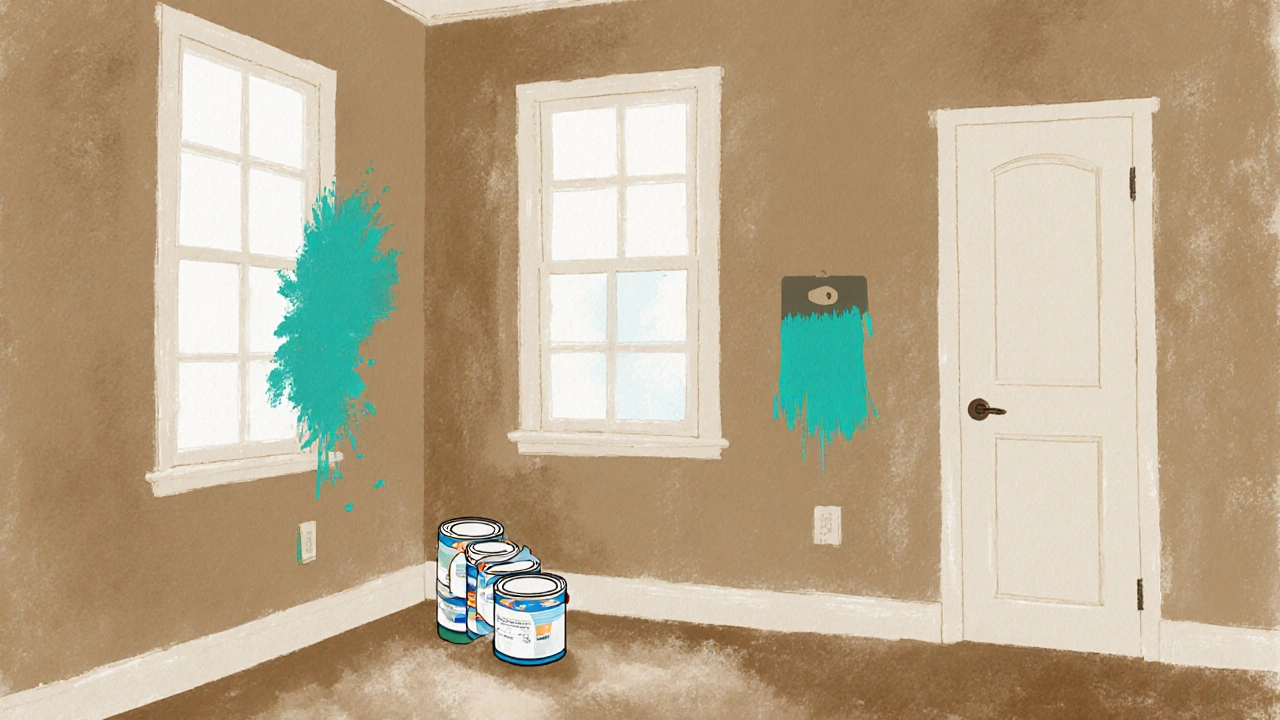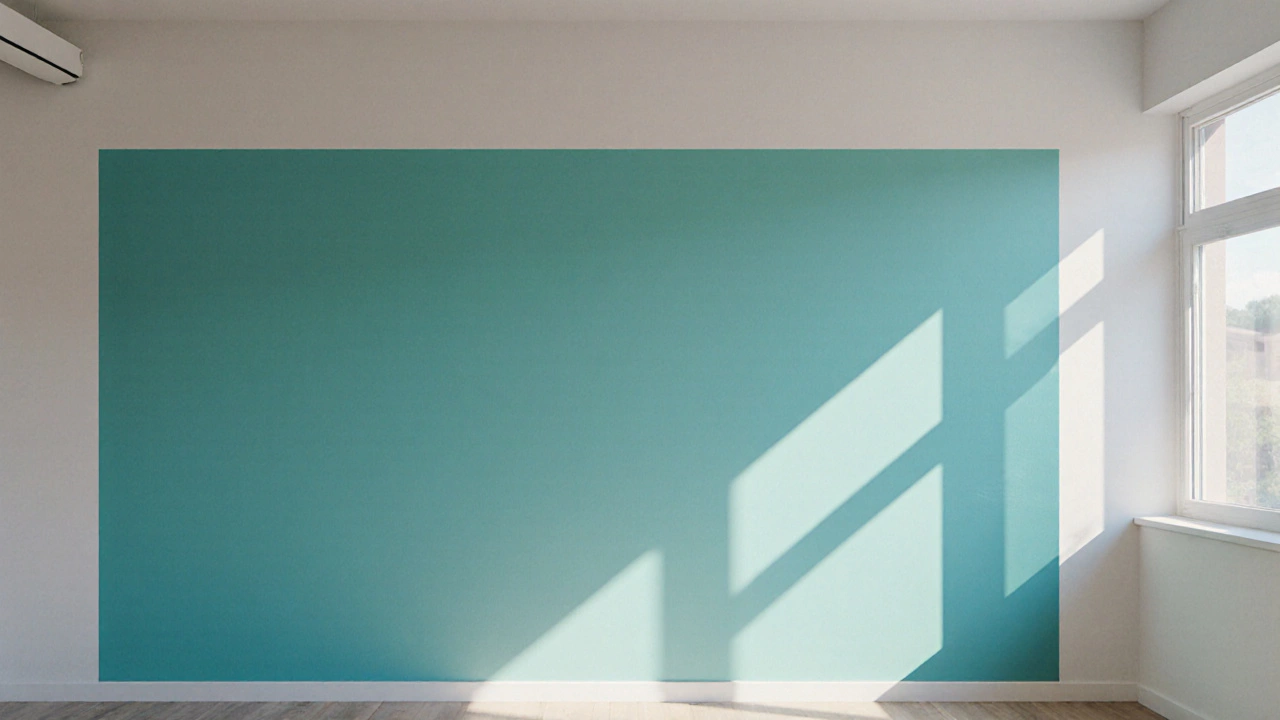Paint Calculator Using 57% Rule
Calculate Paint Needed
Estimated Paint Needed
* This calculation uses the 57% rule for optimal paint usage based on real-world application data
Ever wondered why you sometimes end up with a half‑finished wall or a tub of paint left untouched? The secret often lies in how much paint you actually need versus how much you buy. Enter the 57 rule for painting - a simple shortcut that helps homeowners and DIYers estimate the right amount of paint without over‑buying or under‑estimating.
What Exactly Is the 57 Rule?
57 rule for painting is a heuristic that suggests you should aim to cover about 57% of a wall’s total surface area with paint in a single coat. The remaining 43% accounts for wastage, texture, and the second coat most projects require. In practice, this means you calculate the wall area, multiply by 0.57, and then use the paint’s coverage rate (usually expressed in square meters per litre) to determine how many litres you’ll need.
Why 57%? The Logic Behind the Numbers
The rule emerged from industry studies that tracked real‑world painting projects. Researchers found that, on average, only 57% of the paint applied actually contributes to a uniform, opaque finish. The rest is lost to spillage, brush‑rollover, surface imperfections, and the inevitable second coat. By planning for 57% coverage, you build a buffer that keeps the project on schedule and within budget.
Key Elements That Influence the Rule
- Paint coverage ratio - Manufacturers list how many square metres a litre will cover under ideal conditions.
- Wall surface area - Total area of all walls you intend to paint, minus doors and windows.
- Primer - Pre‑coating can boost the effective coverage, especially on porous surfaces.
- Paint finish (matte, satin, gloss) - Higher‑sheen paints often require less material because they spread more evenly.
- Sheen level - Determines how many coats you’ll need for full opacity.
Step‑by‑Step Guide to Using the 57 Rule
- Measure each wall’s length and height. Multiply to get square metres. Add up every room you plan to paint.
- Subtract the area of doors, windows, and any built‑ins you won’t be painting.
- Take the total from step 2 and multiply by 0.57. This gives you the “effective paintable area.”
- Check the paint can for its coverage rate (e.g., 10 m² per litre). Divide the effective area by this number to calculate litres required.
- Add a 10‑15% safety margin for unexpected issues, especially if you’re on a textured wall or using a low‑VOC formula.
- Purchase the calculated amount, rounding up to the nearest full litre or half‑litre pack.
By following these steps, you’ll avoid the common pitfall of buying too much paint - a waste of money and storage space - while also preventing the frustration of a half‑finished wall.
Practical Example: A Living Room Redo
Imagine a modest Melbourne living room: four walls, each 4 m wide and 2.5 m high. Two windows (1.2 m × 1 m each) and one door (0.9 m × 2 m) won’t be painted.
- Total wall area: 4 walls × 4 m × 2.5 m = 40 m².
- Subtract windows: 2 × 1.2 m² = 2.4 m².
- Subtract door: 0.9 m × 2 m = 1.8 m².
- Paintable area: 40 - 2.4 - 1.8 = 35.8 m².
- Effective area (57%): 35.8 × 0.57 ≈ 20.4 m².
- If the chosen paint covers 10 m² per litre, you need 20.4 ÷ 10 = 2.04 L.
- Add 15% safety margin: 2.04 × 1.15 ≈ 2.35 L. Round up to 2.5 L.
Instead of grabbing a 4‑litre bucket, you’d purchase a 2.5‑litre pack, saving money and avoiding excess leftover paint.
Tools That Make Calculations Easy
Many paint manufacturers now offer paint calculators on their websites. Simply plug in room dimensions, select surface type, and the tool applies a rule similar to the 57% heuristic automatically.
For those who love spreadsheets, a quick Google Sheet formula can do the job:
= (Length*Height*NumberOfWalls - OpeningAreas) * 0.57 / CoverageRate * 1.15
Replace the variables with your measurements, and you’ll get the exact litres needed.
Common Mistakes and How to Avoid Them
- Ignoring texture: Rough plaster or popcorn ceilings can absorb more paint, pushing the effective coverage lower than 57%.
- Skipping primer: Unprimed surfaces especially new drywall, may require an extra coat, effectively reducing the 57% figure.
- Over‑estimating the finish: Glossy paints spread farther, but matte paints often need a second coat, which means you might need to adjust the rule to 50% instead.
- Not accounting for colour change: Dark to light transitions usually demand a primer or an extra base coat, adding to the total paint volume.

Comparison: 57% Rule vs Traditional 100% Estimate
| Aspect | 57% Rule | 100% Estimate |
|---|---|---|
| Typical wastage accounted for | Built‑in 43% buffer | None - assumes perfect application |
| Cost efficiency | Often 10‑20% cheaper | Higher due to over‑purchase |
| Risk of running out | Low when safety margin added | Very low - but usually unnecessary excess |
| Complexity | Simple multiplication | Simple multiplication (no buffer) |
Most DIYers find the 57% rule hits the sweet spot between cost and confidence. If you’re painting a high‑value feature wall or using specialty finishes, you might still prefer the conservative 100% approach.
When to Adjust the Rule
While the 57% heuristic works for standard drywall and smooth plaster, there are scenarios where you should tweak the percentage:
- Textured walls: Reduce to 45%-50% because more paint gets trapped in crevices.
- Light‑to‑dark colour changes: Increase to 60%-65% to accommodate extra priming.
- Professional finishes: For ultra‑smooth surfacing (e.g., high‑gloss), you might climb to 65% as the paint spreads further.
Final Checklist Before You Start
- Gather a tape measure, calculator, and paint spec sheet.
- Measure each wall, subtract openings, and note the total square metres.
- Apply the 57% multiplier and divide by the paint’s coverage rate.
- Add a 10‑15% safety buffer.
- Buy the rounded‑up amount, preferring the same brand and finish for consistency.
- Prep the walls: clean, sand, and prime if needed.
- Lay drop cloths, tape edges, and stir paint thoroughly before the first coat.
Follow these steps, and you’ll finish with a flawless wall and leftover paint you can actually use for touch‑ups later.
Frequently Asked Questions
Is the 57% rule only for interior walls?
It works best on smooth interior surfaces like drywall or plaster. Exterior siding, brick, or heavily textured walls need a lower percentage because more paint is absorbed.
Do I still need a primer if I follow the 57% rule?
Primer isn’t eliminated - it’s factored into the rule’s built‑in waste buffer. If the surface is new drywall, a primer coat will improve adhesion and may actually reduce the total paint needed.
Can I use the rule for ceilings?
Yes, treat the ceiling as another “wall.” Just remember ceilings often have a slightly higher wastage rate because of drips, so you might add an extra 5% safety margin.
What if my paint can lists coverage in square feet?
Convert the figure: 1 m² ≈ 10.764 ft². Divide the square‑foot coverage by 10.764 to get the metric value, then apply the 57% multiplier as usual.
Should I buy a larger can for future touch‑ups?
If the colour is a staple in your home, buying an extra half‑litre now is cheaper than matching later. Just keep the spare sealed in a cool, dry place.
Armed with the 57% rule, you can plan paint projects with confidence, stick to a budget, and avoid the dreaded “I have paint left over but no wall to use it on” scenario.


